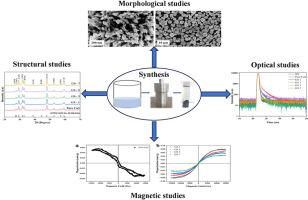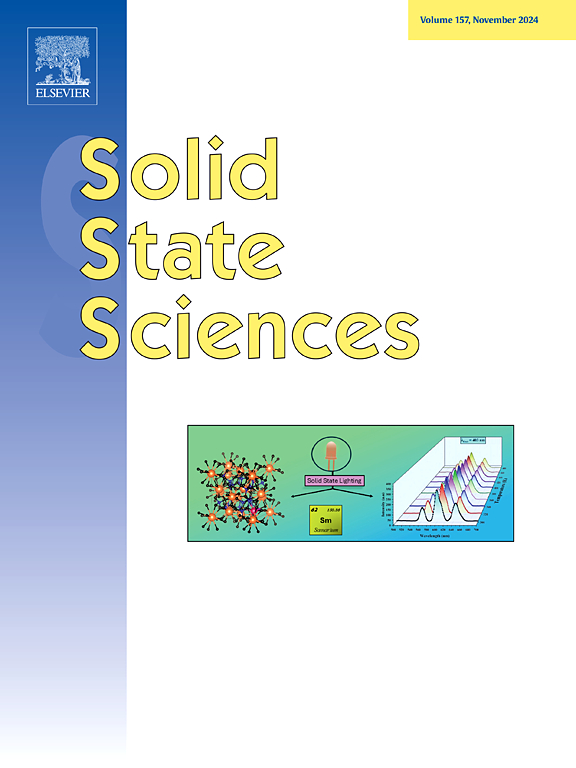钆掺杂对 CuS 纳米结构的结构、光学和磁学特性的影响
IF 3.4
3区 化学
Q2 CHEMISTRY, INORGANIC & NUCLEAR
引用次数: 0
摘要
为了研究稀土离子对 CuS 纳米结构的影响,我们采用水热法合成了一系列掺杂钆的硫化铜(Cu1-xGdxS)纳米结构。这些纳米结构的 x = 0、1、3、5 和 7 的浓度分别为%的浓度下制备了这些纳米结构。研究了所制备样品的结构、光学和磁学特性。粉末 X 射线衍射和拉曼分析用于检查样品的结构分析,并确认了沸石相六方结构的存在。XPS 分析用于研究价态。通过 FESEM 对表面形貌的观察发现,形成了类似纳米球的花形结构,而在较低的放大倍率下则观察到了纳米片。使用紫外可见光谱仪记录的光学反射光谱显示,随着钆浓度的增加,带隙也在增加。荧光分光光度计用于分析室温光致发光。制备的样品在 435 纳米波长处显示出明显的发射峰。荧光寿命研究证实了掺杂钆的 CuS 纳米结构的荧光衰减。磁性测量显示,制备的样品在室温下具有意想不到的超顺磁性。本文章由计算机程序翻译,如有差异,请以英文原文为准。

Influence of gadolinium doping on structural, optical, and magnetic properties of CuS nanostructures
To examine the effect of rare earth ions on CuS nanostructures, a series of Gadolinium-doped copper sulphide (Cu1-xGdxS) nanostructures were synthesized through the hydrothermal method. These nanostructures were prepared at x = 0, 1, 3, 5, and 7 at. % concentrations. The prepared samples’ structural, optical, and magnetic characteristics were investigated. Powder X-ray diffraction and Raman analysis were performed to examine the structural analysis of the samples and confirm the existence of a covellite phase hexagonal structure. XPS analysis was conducted to study the valence states. Observations of the surface morphology study from FESEM reveal the formation of flower-shaped structures resembling nanospheres, while at lower magnification nanoflakes were observed. Optical reflectance spectra were recorded using UV–Vis spectroscopy, which showed the increase in bandgap as the concentration of Gd rises. The fluorescence spectrophotometer was utilized for the analysis of room-temperature photoluminescence. The prepared samples showed significant emission peaks at 435 nm. Fluorescence lifetime studies were carried out to confirm the fluorescence decay of CuS nanostructures doped with Gd. Magnetic measurements revealed that prepared samples exhibit an unexpected superparamagnetic nature at room temperature.
求助全文
通过发布文献求助,成功后即可免费获取论文全文。
去求助
来源期刊

Solid State Sciences
化学-无机化学与核化学
CiteScore
6.60
自引率
2.90%
发文量
214
审稿时长
27 days
期刊介绍:
Solid State Sciences is the journal for researchers from the broad solid state chemistry and physics community. It publishes key articles on all aspects of solid state synthesis, structure-property relationships, theory and functionalities, in relation with experiments.
Key topics for stand-alone papers and special issues:
-Novel ways of synthesis, inorganic functional materials, including porous and glassy materials, hybrid organic-inorganic compounds and nanomaterials
-Physical properties, emphasizing but not limited to the electrical, magnetical and optical features
-Materials related to information technology and energy and environmental sciences.
The journal publishes feature articles from experts in the field upon invitation.
Solid State Sciences - your gateway to energy-related materials.
 求助内容:
求助内容: 应助结果提醒方式:
应助结果提醒方式:


